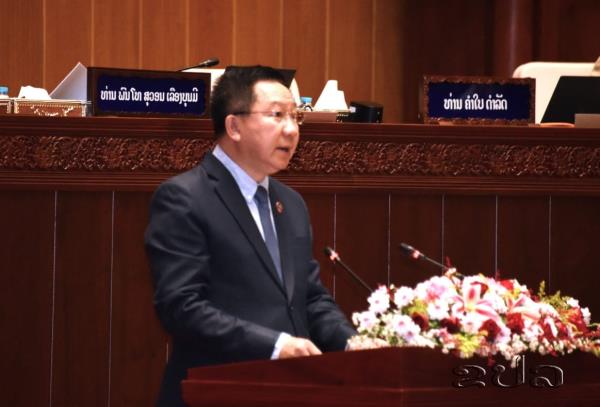ຂປລ
Minister of Agriculture and Forestry, Mr Linkham Douangsavanh, presented the Vision 2040 and Strategy 2030 for Land Management and Development draft during the National Assembly's 8th Ordinary Session of the 9th Legislature on November 25.

(KPL) Minister of Agriculture and Forestry, Mr Linkham Douangsavanh, presented the Vision 2040 and Strategy 2030 for Land Management and Development draft during the National Assembly's 8th Ordinary Session of the 9th Legislature on November 25.
The initiative seeks to preserve 4.5 million hectares of agricultural land, equivalent to 19% of Laos’ total land area, while providing a strategic framework for sustainable land use and development.
The strategy encompasses five core components aimed at supporting Laos’ socio-economic development goals. It prioritizes food security, increased agricultural production for domestic consumption and export, and enhanced land management practices aligned with national policies.
Minister Linkham highlighted key milestones leading to this proposal, including the 2017 Party Central Committee's Resolution No. 026/CPCC, which emphasized improved agricultural land management and maintaining forest cover at 70%. Additionally, the National Assembly approved the National Land Allocation Master Plan (Resolution No. 098/NAS) in 2018, dividing the nation’s land into eight categories. Agricultural land was allocated as follows: rice fields: 2 million hectares (44% of agricultural land), land for annual crops: 1 million hectares (22%), land for perennial crops and fruit trees: 0.8 million hectares (18%) and grasslands for livestock grazing: 0.7 million hectares (16%)
The agriculture and forestry sector has advanced participatory land-use planning at the village level, conducted surveys of irrigation zones, assessed land quality, and established reserved zones for agricultural production. Progress includes creating model farming families and finalizing key agreements and regulations.
However, challenges remain in completing detailed national surveys, zoning, and agricultural land-use plans. Implementation of markers for designated land reserves also lags behind schedule.
Once approved, Vision 2040 and Strategy 2030 are expected to transform the National Land Allocation Master Plan into a strategic framework for efficient agricultural land management, establish clear classifications and land-use plans for the 4.5 million hectares of agricultural land, guide government sectors and local authorities in integrating land-use practices into socio-economic development plans as well as strengthen food security and expand agricultural production for domestic and export markets.
“The draft strategy is a significant step toward sustainable land management and agricultural development, ensuring that the sector remains a cornerstone of Laos’ socio-economic growth,” Minister Linkham concluded.
The long-term vision positions Laos to sustainably manage its agricultural resources, support rural livelihoods, and contribute to national and global food security.
KPL